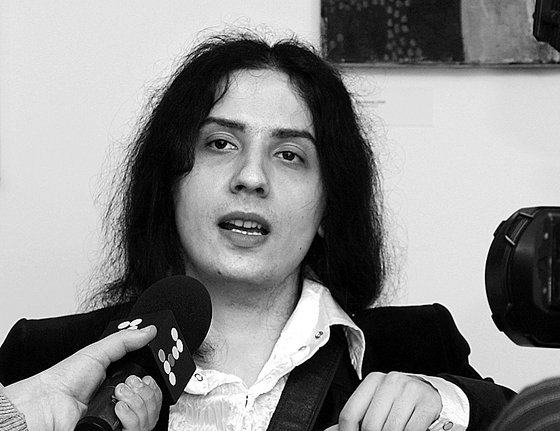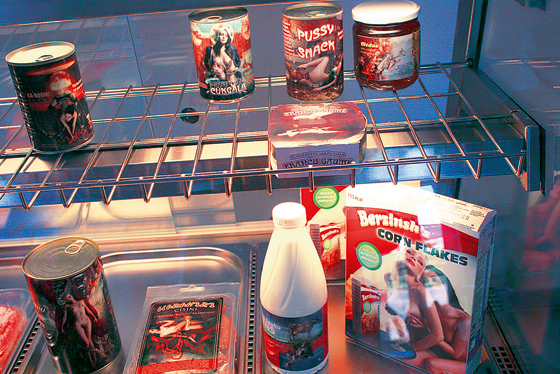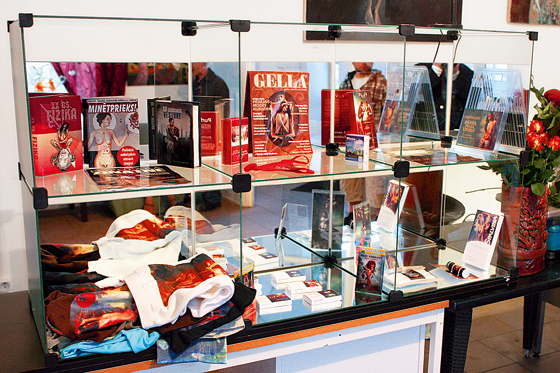|
|
| Artūrs Bērziņš Katrīna Teivāne-Korpa, Culture Theorist | |
| Artūrs Bērziņš (born 1983) is a master’s graduate of the Latvian Academy of Art Department of Visual Communication, one of the most original to emerge from this department in recent times. The artist, who has actively participated in exhibitions for 10 years now, has forged the reputation of being a “refined hooligan”. And, quite so, his creative output – visually expressive and mannerly works – tends to trigger emotions which can make thoughts fidget and wriggle, unable to find a comfortable position among the impressions gathered. The provocative tendency of Bērziņs’ art has also been confirmed by the fact that his work was included in one of this summer’s most interesting expositions The Naughty Ones. Artists as Challengers of Society, held at the exhibition hall Arsenāls. Meanwhile, from 11 till 21 June the artist offered an exhibition of his latest works Aizmirsto sapņu bode (‘Shop of Forgotten Dreams’), also the work for his Master’s degree, in a former plumbing shop at the more threatening end of Ģertrūdes iela (No. 110). | |
 Artūrs Bērziņš. 2012 Photo: Dmitrijs Jandola | |
| In general terms, Bērziņš’ creative work is characterized by a varied range of voluptuous erotica, intensified imagery, dream-like scenes and decorativeness weighed down by visual metaphors and contrasts teetering on the edge of symbolism, postmodernism with its characteristic plundering of stylistic purity, citations and irony, and highlights the acutely romantic shadings typical of gothic art. This last association especially makes me linger most frequently in front of the author’s works, even though just as palpably symbolism, Art Nouveau and more recent influences can be discerned in them in equal proportions. Gothic art is not a common phenomenon here and consequently it is quite compelling. One has to agree with the artist that since the second half of the first decade of the 21st century this tag cannot really be applied to him, although sometimes the temptation does arise, especially when seeing the long-haired youth whose hobby is the creation of dark electronic compositions (in the groups Diadema and Koronar), setting off on his business dressed in a velvet jacket (so becoming of the sub-culture) revealing the high, pointy collar of a white shirt. Pure gothic style is limiting, both stylistically as well as thematically, and hence its affectation and sensuously touching message inevitably becomes boring. But whatever else, it cannot be said that Bērziņš’ works are boring. Although predictable, as a whole, his dark advertisement-like signature style has developed over the years and definitely become more interesting, more multilayered. And once again – the exhibition Shop of Forgotten Dreams proves this. The artist speaks of painting as his main area of activity, but he also works with oils and uses photography and digital “brushes”, creating so-called photo-paintings. Discussing the inclusion of photography in his creative work, Bērziņš mentions that through this a work’s fantastical subject gains a new dimension, a peculiar illusion of reality which is inherent in the documentary nature of a photograph. This inadvertently reminds us of the old conflict between painting and photography, where the latter was allocated the niche which had become too narrow for its “older sister” with the implication that “you can’t really do anything more than a shabby depiction, stay with that then!”, but allowed painting to go off into enthusiastic creative explorations. The history of art of the 20th and 21st centuries, too, is rife with examples which show how both of them have fared and what it has led to, what sort of boundaries have been set or removed, however, when looking at Bērziņš’ works, one wants a just a little bit of sentimentality – see, they’ve both met up here, so that hand in hand they each give their equally important contribution towards the creation of the artwork... | |
 Artūrs Bērziņš. Shop of Forgotten Dreams. Views of the exhibition. 2012 Photo: Aldis Bērziņš Publicity photos Courtesy of the artist | |
| The press release, with colourful strings of words and enriched with foreign terms, stated quite clearly what we’d see at the exhibition and what it was all about, so I was able to abandon myself to peaceful observation. The first hall revealed an installation for the attention of viewers. It was a mirrored showcase eliciting joyful memories, occupied by a collection of products made up as strange erotic toys and supplemented by heavy Soviet-era (in other words – old) scales, which this time seemed to be more suitable not for measuring weights, but for weighing up the question: “to be or not to be?” That’s how respectable they looked against the background of all the rest. Behind the showcase one could view Bērziņš’ older works – some oil paintings created between 2003 and 2010, which were used for illustrations on the packaging of the items. In the second hall, as an adjunct to the primary exposition, one could view large scale printouts of the photo-paintings created this year, which had also been printed on the products. About the choice of shop premises as an exhibition space Bērziņš tells us: “On the days when I am working at home, I take a stroll around the neighbourhood during breaks. Then stumbling upon out of the way places where I haven’t been for about 10 years, I get overcome by a kind of nostalgia for the old days. So on one of these walks, like pieces of a jigsaw puzzle, the conceptual picture of a pseudo-shop gradually began to take shape.” The empty shop premises on Ģertrūdes iela was the missing piece of the mosaic: “The last corner of the last building on the central street, separated from the gloomy Maskava suburb by a railway tunnel – the border zone – as if a segment of unstable reality had wandered into the city landscape, in which a viewer has the chance to get slightly lost and disappear from their worry-filled everyday life. A phantom shop, from an era in which small shops with their unique atmosphere and vision which their owners had imbued in them were able to co-exist in parallel with functional, yet lifeless supermarkets. From a reality in which things had not been disinfected and cleansed of their colour and unique flavour.” The fact that the work has been created like an imitation of a non-existent reality is also underlined in the written description of the exhibition that emphasises the “simulacra” concept of Baudrillard. | |
 Artūrs Bērziņš. Shop of Forgotten Dreams. Views of the exhibition. 2012 | |
| That then is the “forgotten dream”: an alternative. These days there is such a diversity of life styles, types of things and so on, apparently, allowing each and every one to select what they like and what suits them best. But is this an illusion again, gently nursing our sweetly dozing minds? An extended cage is still a cage, and a supermarket is an appropriate symbol of this. The design of the various brands of goods available in Bērziņš’ shop simulacra highlight the most striking motifs in his creative work – gorgeous semi-naked or naked ladies in quite openly erotic flirtation invite one to try some breakfast cereal, to read some absorbing literature about love matters which would awaken in every respectable girl the female vamp, or to find out about the achievements of physics in the 20th century. Bērziņš often livens up his works with the portrayal of some confusing physiological process, or of an internal digestive organ. For example, a book of crossword puzzles is adorned by a drawing of the intestinal tract portrayed as a labyrinth. The task is to find the exit for a berry that’s been swallowed by a young lady. A reference to the digestive process is also useful to illustrate the insatiability of consumer society. Look, even the beauty has an upset stomach from a carelessly composed menu, and the tender intestines have become blocked, creating a string of stale sausages (a packet of Harakiri sausages). One doesn’t even want to think about what’s in the filling of an “8th of March” sweet. Contrasting the ugly or uncomfortable with the romantically beautiful has a significant place in Bērziņš’ creative work. In this way the beautiful seems more fragile and moving, to be protected and admired. In the work Meteo, a “little dove” released by a gently dozing creature transforms into a little cloud which provides welcome rainfall for a thirsting plant. In the photo-painting Siesta, flatulence from the body of another sleeping beauty becomes, to the delight of little angels, airy soap bubbles reflecting the play of light. And once again you want to believe that beauty will save the world, because, at its very foundations, it is purely and only good. There are also more dramatic moods – for example, on the packet of minced meat one can see lovers, whose passion (bodies) is serenely minced into an indeterminable mass by inexorable mundaneness (a meat grinding machine). And how can one possibly swallow a bite of meatball after this?! The lid on “20th century history” evokes sombre hopes: a concentration camp prisoner and her guard console each other in shared mourning. Among the range of products in the showcases there is a set of paint brushes decorated by the artist’s self-portrait: the author as Saint Sebastian, whose body is pierced by arrows – paint brushes, because “art demands sacrifices”. In the showcases, between the randomly arranged books, packs and packets, shirts and underpants, cans and little boxes, there is the obligatory arsenal of medicines. This, it must be said, caused a certain disappointment and also in the most blatant way represented, to my mind, the overall problem with the exhibition, that is the constant feeling that this nevertheless has been a study exercise. Within the boundaries of the means of expression that he favours, the author has successfully solved the tasks relating to the illustrative part of the exhibition concept, but one would have liked a bit more attention to the reading matter as regards the listing of the product qualities and their names. For example, the name of the tablets Pretgalvsapīns (‘Antiheadachin’) seems particularly clumsy. No head, no pain? One does have a head, and pain is inescapable? The medicines on their own, as pure stuff free of the demands of pharmacy companies? If nothing else, an image of the packaging alone would have been quite sufficient, utilising the photo-painting Vientulība (‘Solitude’) – a mournful, cleft moon in the sky and two unfortunates on the sea shore. Quite clearly, it hurts, and it’s doubtful whether medicine will help... The name of the medicine transforms the fatalistic and ironic spark evident in this image into a schoolboy joke, and this seems superfluous. Whatever else, the search for meaning in the product illustrations was much more interesting when not paying attention to their names and the distracting associations of their descriptions. The annex to the exhibition in the second hall offered a peaceful viewing of photo-paintings, which was just what was needed. Freed of the burden of a vitamin complex the work Placenta seemed a pleasant version of the processes taking place in a person’s internal world – an interpretation about the development of the refined relationship between the masculine and the feminine (within us). The work Ironija remained in memory (thanks to the model and TV show ‘Cinderella’ winner Kristīne Teilāne) which attracted the attention of the society press, where in the light, dreamy interior a girl clothed in flimsy garments is holding in her hands a little lap dinosaur which, unrestrained, has already sunk his teeth into a model of Riga sitting on the table. In other words, in the second hall one could quietly walk around, stay awhile and, if one wanted, to succumb. To relax rather than undergo a catharsis, which, as the artist once stated, would be the desirable result of visiting his exhibition. Translator into English: Uldis Brūns | |
| go back | |







